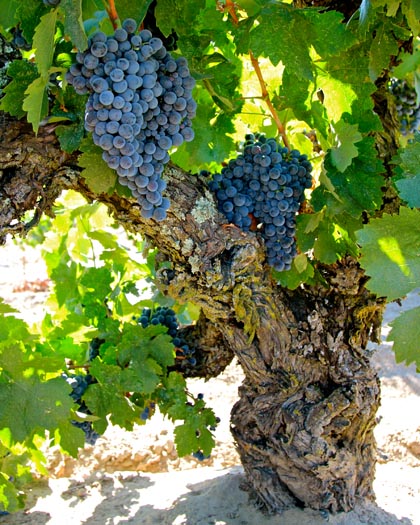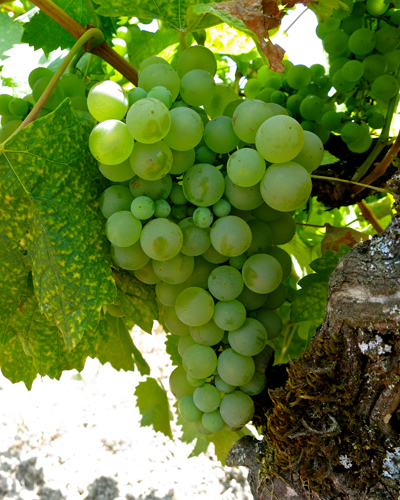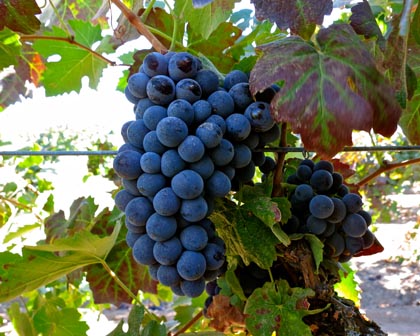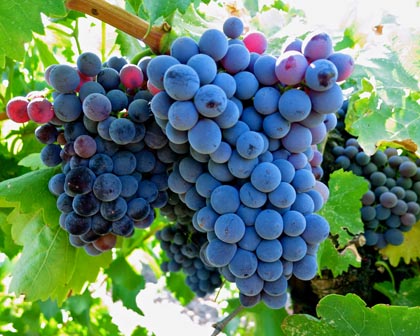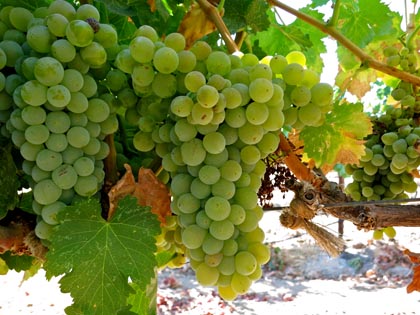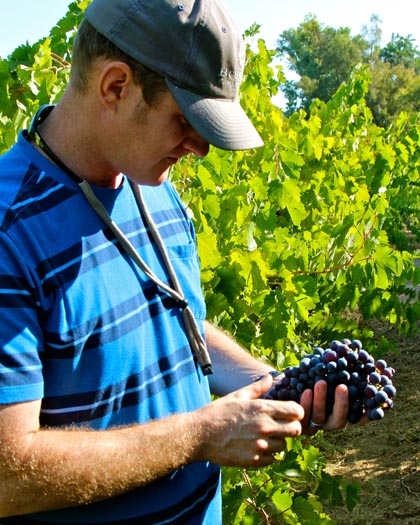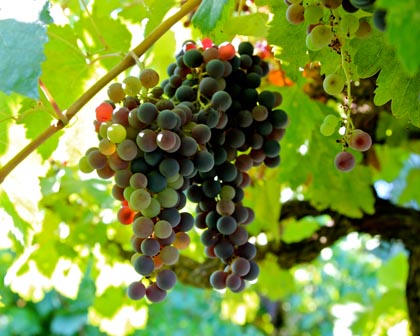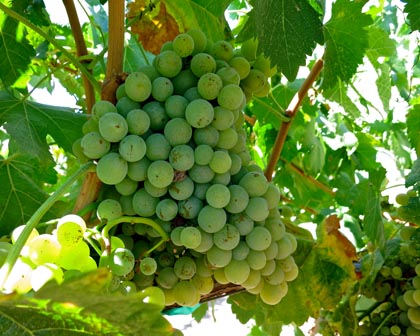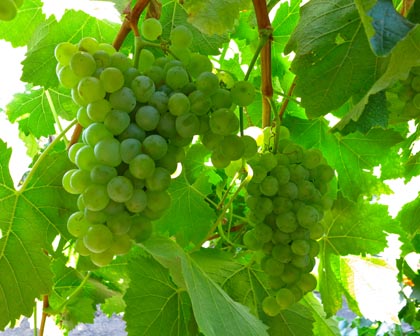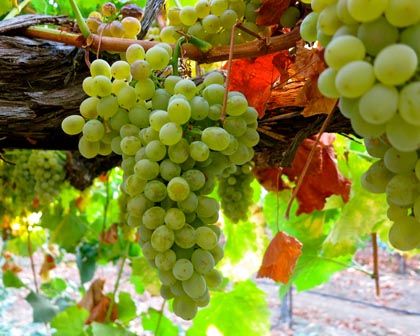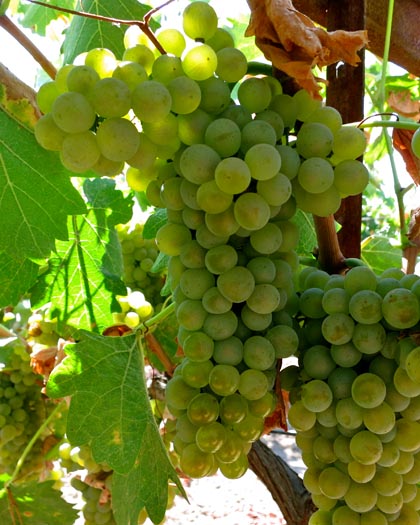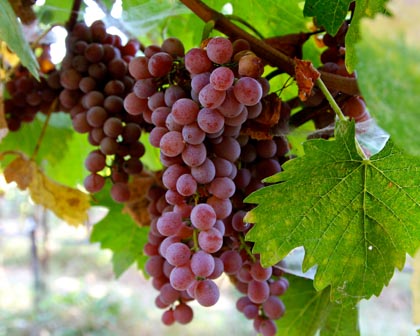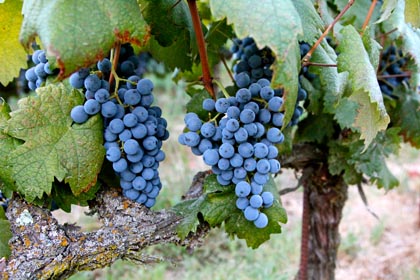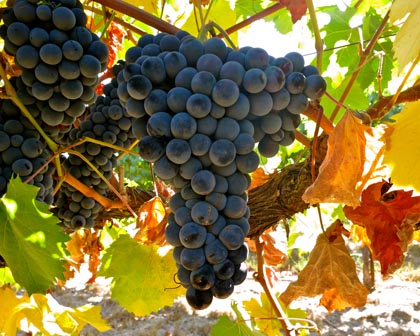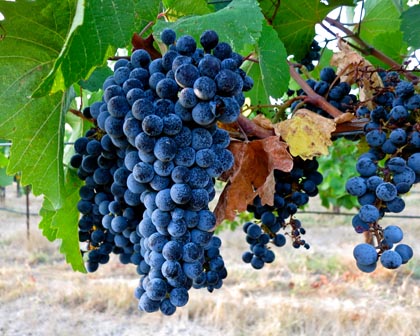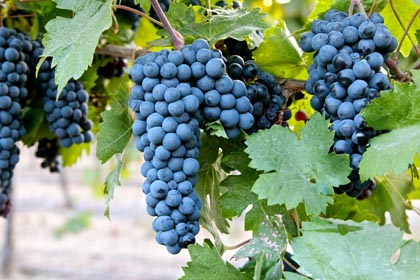Letters from Lodi
An insightful and objective look at viticulture and winemaking from the Lodi
Appellation and the growers and vintners behind these crafts. Told from the
perspective of multi-award winning wine journalist, Randy Caparoso.
Lodi’s alternative wine grapes, headed towards photo finish
Majestic 107-year old Carignan vine in Jean Rauser’s east-side Mokelumne River-Lodi vineyard: recalling another era (in the 1970s), when Carignan was the most widely planted wine grape in all of California.
According to the 2012 Grape Acreage Report put out by USDA's National Agricultural Statistics Service, approximately 10.2% of the total acreage of fruit bearing wine grape vines in California can be classified as "other" — including many of the “alternative” style varietals more common to Lodi than in other American wine regions, such as Albariño and Aglianico, Cinsaut and Souzão, Vermentino and Verdelho, Graciano and Teroldego, Marzemino and Montepulciano, Symphony and Schönburger, Touriga and Torrontés, Pinotage and Piquepoul, and many others of, frankly, commercially obscure identity, from Albalonga to Zweigelt.
The other 89.8% are among the following list of California's 16 most widely planted varieties or crossings of Vitis vinifera – that is, grapes originating from the European family of grapes going primarily into wine (as opposed to raisins, or eaten as table grapes). According to the 2012 report:
Colombard, not Chardonnay, was once the most widely planted white wine grape in California
1. Chardonnay (93,153 acres)
2. Cabernet Sauvignon (76,691 acres)
3. Zinfandel (46,857 acres)
4. Merlot (45,260 acres)
5. Pinot Noir (38,049 acres)
6. French Colombard (21,020 acres)
7. Syrah (18,620 acres)
8. Sauvignon Blanc (14,911 acres)
9. Pinot Gris (12,473 acres)
10. Rubired (10,903 acres)
11. Petite Sirah (7,957 acres)
12. Barbera (6,286 acres)
13. Chenin Blanc (5,936 acres)
14. Grenache (5,846 acres)
15. Ruby Cabernet (5,801)
16. Carignan (2,547 acres)
Apart from this, there is a total of 46,877 acres of "other white wine" (25,212 acres) and "other red wine" (21,665 acres) grapes planted. By a good margin, the five most planted wine grapes in California today are Chardonnay, Cabernet Sauvignon, Zinfandel, Merlot and Pinot Noir; and these five grapes alone account for 65.33% of California's total acreage.
Let’s put this in perspective: just over 40 years ago, in 1972, the five most widely planted grapes in California, used mostly to produce jug wines, were (in order of most acres) Carignan, French Colombard, Zinfandel, Grenache and Barbera. These five accounted for 44% of the wine grapes grown at the time (according to Martin and Heien, California’s wine industry enters a new era). Sure, there were considerable amounts of Chardonnay and Cabernet Sauvignon grown in California 40 years ago. But Chardonnay and Cabernet Sauvignon did not become dominant until the mid-eighties; when premium varietal wines began to outsell generic jug wines, and the industry was planting new vineyards as fast as possible to keep up with consumers' growing taste for finer things in life.
Barbera in Jahant-Lodi’s Leventini Vineyard (goes to St. Amant and Macchia): as of this week, a little tart, a few weeks away from harvest
40 years ago there was virtually no Pinot Gris grown in California; just a tiny amount of Pinot Noir, and miniscule proportions of Syrah and Merlot. French Colombard, Rubired, and Ruby Cabernet were more widely planted in the seventies, and are still around today – but you may be asking, what the heck are these?
French Colombard (a.k.a. Colombard) is an originally French variety whose usefulness has persisted through the wine industry's modern era, primarily as a component in white wine blends. In fact, 20-30 years ago, French Colombard was regularly bottled as a varietal white wine by wineries like E. & J. Gallo and Almaden. Recently, Boisset Family Estates has been trying to rekindle interest in this varietal (which produces very pleasant, light, flowery, fruity, mildly stony white wines) under their Buena Vista Vinicultural Society label.
While Colombard is still a significant grape in warmer parts of San Joaquin Valley (south of Stockton, from Fresno to Bakersfield), there are less than a 1,000 acres remaining in the Lodi AVA (out of over 100,000 acres of wine grapes planted here). Do not be surprised if at least one enterprising Lodi premium winery starts to produce a varietal Colombard; which, after all, could be considered something of an heirloom grape (according to Thomas Pinney in A History of Wine In America, Colombard was one of the French grapes selected by California wine pioneer Pierre Pellier, and planted in the San Jose area in the 1850s).
Classic Grenache in Acquiesce Vineyard (Mokelumne River)
Rubired (Alicante Ganzin x Tinta Cão) and Ruby Cabernet (Cabernet Sauvignon x Carignan), on the other hand, are both black skinned crossings of Vitis vinifera, developed by U.C. Davis' Dr. Harold Olmo over 50 years ago for warmer growing regions in the Central Valley. These grapes always go into red wine blends – you never see Rubired or Ruby Cabernet bottled as varietals – and even so, have all but disappeared from vineyards in Lodi.
In Lodi, as in elsewhere in the state, varieties like Grenache, Carignan and Barbera have recently been enjoying a resurgence in interest among consumers, looking for alternative style wines. Although they used to be common workhorse grapes, they are now considered "cool" precisely because their acreage has dwindled, and because they have always made red wines of distinctive, if perennially underrated, qualities. Perhaps not as deep flavored as Cabernet Sauvignon or Merlot, and not as refined as Pinot Noir — but as in all things, it is very possible for varietals like Grenache, Carignan and Barbera to be so far out of fashion that they suddenly become "in."
Acquiesce grown Grenache Blanc: variant of Grenache Noir, becoming popular among winegrowers and consumers as a white wine variety
One of the fun things about this time of year is that you can see and taste wine grapes on the vine just as they are about to be picked — their softening skins taking on vivid pigments, and their pulp bursting with sugar and zesty acidity. If you count the clonal variants, there are over 100 different varieties of fine wine grapes planted in the Lodi AVA (see 100 grapes of Lodi). No, Lodi doesn't grow everything – there are easily over 1,000 different grape varieties of significance grown all around the world – but there certainly is more diversity of wine grapes grown here in the Delta than in any other wine region in the U.S. (and hence the world). It helps to have a steadying, moderate Mediterranean climate, and rich yet porous, vine-friendly soils.
Here are some recent photos (all taken during the past two weeks) of some of the more interesting grapes growing in Lodi that are being made into the types of alternative style wine capturing the imagination of more and more consumers by the day:
Eric Pooler, Boisset Family Estates vineyard manager, examines cluster of Lodi grown Mission: a historic variety, first brought to California by Franciscan missionaries in the 18th century (Boisset produces sweet, fortified Angelica wines from these grapes).
Colorful, but slow ripening, Mission grapes, farmed in Mokelumne River-Lodi by Mike Agnagnos
Piquepoul Blanc: a Southern French variety bottled as Picpoul Blanc by Lodi’s Acquiesce Winery, producing the kind of light, lemony tart, dry white wine that appeals to many consumers today
The lush, exotically perfumed Torrontes grape — here, grown by Silvaspoons Vineyards in Lodi’s Alta Mesa AVA — is hugely popular in Argentina, and just beginning to catch on in California
Silvaspoons Vineyards’ Verdelho grapes (a Portuguese native) are oval shaped berries that explode with lemon, lime and tropical fruit flavors
Acquiesce’s Mokelumne River-Lodi grown Viognier — native of Southern France, and tasting of honeysuckle and lavender — was just picked this past weekend
This beautifully pink colored Schonburger — a fairly recent German crossing of Pinot Noir x (Chasselas x Muscat Hamburg) — is grown by Mokelumne Glen on Lodi’s east-side, and is made into a delicate, tropical fruit scented white wine by some tiny producers
Graciano in Bokisch Ranches’ Las Cerezas Vineyard (Lodi’s Mokelumne River AVA): producing a red wine that has achieved almost “mini-cult” status with its plump, plummy fruit tinged with cardomom-like spice and loamy earth tones
Mokelumne Rim Vineyards Teroldego: a Northern Italian grape that goes into Peltier Station’s thick, black, powerful varietal bottling, smacking of dried berries and mocha espresso spice
Zweigelt in Mokelumne Glen: an Austrian crossing (St. Laurent x Blaufranksich) producing moderately weighted yet firm, spicy reds
Picture-perfect Primitivo in Harney Lane’s estate vineyard (Mokelumne Rivver-Lodi): a clonal variant of Zinfandel prized for its long, loose cluster morphology (helping to resist bunch rot common to Zinfandel) and more even sized berries (resulting in less “jammy” flavor than “regular” Zinfandel, with its “hens-and-chicks” sized berries)
